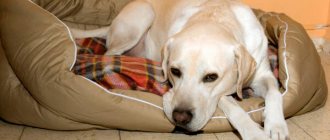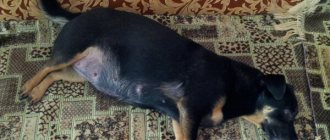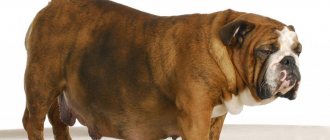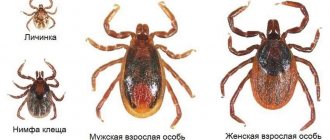The first birth of a dog is an important event both for the bitch herself and for her owner. In most cases, dog births take place with minimal human intervention, but still this matter should not be left to chance. If you study information about how childbirth occurs in dogs, you can recognize its first signs, assess the situation and understand whether the woman in labor needs to be assisted, or whether she can cope on her own. In order not to panic when the dog begins to give birth, to behave competently, you need to know how to deliver a dog at home.
Preparing for childbirth
Preparations for the birth of a dog should be done in advance. Knowing the exact date of mating, it is easy to determine the date of birth of the dog. As a rule, pregnancy lasts 58-66 days. Often a small dog gives birth a little earlier, while larger breeds give birth a little later. Premature births in dogs are rare; this may be due to pathology. When labor begins early, consultation with a specialist, and sometimes his help, is required.
A week before the dog is expected to give birth or prenatal signs appear, the area needs to be prepared. It’s good if there is a suitable separate room for this. If not, then you need to choose a corner where it will be warm, there will be no drafts and bright light. The optimal temperature suitable for a whelping bitch is from 20°C to 25°C.
It is important that this place is not on the aisle, and that household members do not disturb the dog during this period. In addition, the maternity place should have easy access to those who will monitor the process and provide assistance if necessary.
What is needed for childbirth, besides a prepared place:
- a box where born puppies can remain while the next ones are born;
- a lot of unnecessary clean cloth made from natural fibers, which can be laid under the dog, in a box for puppies, or to wipe them off if the bitch does not have time to lick everyone;
- clean water for wiping the woman in labor, puppies, and for washing hands;
- sterile bandages or gauze wipes;
- white cotton threads disinfected in alcohol for ligating the umbilical cord;
- clean scissors with rounded edges;
- medical tweezers with a lock;
- a means for disinfecting the belly buttons of puppies (brilliant green, potassium permanganate solution, or special disinfecting sprays).
The dog drinks a lot of water before and during birth, so a bowl of water should always be nearby. You can’t pour a lot of water into it at once; you need to drink it little by little, but often.
What you will need during childbirth
If the birth will take place at home, or you plan to assist the veterinarian, wash and disinfect your hands and cut your nails short. Wear comfortable clothes (you'll have to throw them away later). You will need:
- A large oilcloth and an old sheet to put under the dog;
- Warmer;
- Basin for soiled rags;
- Thermometers: standard, veterinary and room;
- Box for puppies;
- Tray for sterilized medical instruments;
- Syringes, pipettes, tweezers, scissors;
- Cotton wool, sterile gauze wipes;
- Silk sterile threads will be required for ligating the umbilical cord;
- Scales;
- Woolen threads of different colors - mark puppies;
- Clock, notebook, pen (record the time of birth, appearance of puppies).
Prepare the following medications:
- Medical alcohol;
- Glucose 5% in ampoules;
- Hydrogen peroxide;
- Traumeel;
- Syntomycin ointment 10%;
If labor begins prematurely, additional medications will be needed. Before labor begins, thoroughly wash the dog’s genitals and abdominal area, and trim the hair there shorter. Trim your long mustache and beard so as not to interfere with the umbilical cord biting.
Veterinary consultation before birth
If the bitch’s pregnancy is going well, information on how to give birth to dogs has been studied in detail, the process proceeds without complications, then the help of a veterinarian may not be required. But before the end of pregnancy, it is advisable to visit a veterinary clinic, do an ultrasound examination and get advice from a specialist.
An ultrasound will show how many puppies should be born, how they are lying, and whether there is any pathology. If you find out in advance how many puppies a dog can give birth to, you will be able to monitor the completion of the birth and take timely measures if the last puppies are not born for a long time. If puppies are lying incorrectly, you will be prepared for complications, you will understand why this happens, and you will know how to help your dog in this case.
A specialist at the veterinary clinic will tell you what to do if there are signs of impending birth, what medications you need to purchase in case the dog’s birth process goes wrong, how and in what doses to use them.
Medicines that stimulate labor must be used wisely, after consulting a specialist. If you are not confident in yourself, do not understand when you can use them and when not, then it is better to entrust this to a veterinarian. Taking medications incorrectly can lead to uterine rupture, death of puppies, and even death of the dog.
Regardless of whether you will be providing obstetric care for the first time or have done this several times and have experience, it is advisable to enter into an agreement with a veterinarian so that in an unforeseen situation, assistance to the dog can be provided at any time.
How to help a woman in labor?
The main rule is “do no harm.” In this case, this commandment means: do not force events. No matter how hard it is to look at the torment of a dear creature, a person can only control time and provide all possible assistance:
- A light abdominal massage in time with the contractions will help relieve your pet’s pain;
- if the cub comes out halfway and gets stuck, you can carefully pull it towards you at the moment of relaxation of the female’s peritoneum (you need to cover the entire body with your palm, and not drag it by the paws, tail or head; Vaseline will make the work easier: you need to lubricate the loop around the puppy);
- the bedding under the woman in labor should be periodically changed so that she does not lie on wet soil (experienced owners stock up on a pack of diaper diapers);
- you need to blot the bitch’s anus and vulva with clean wipes: hygiene will protect the offspring from accidental infection;
- Giving the mother small doses of liquid will help restore her water balance (you can offer goat's milk or glucose).
Harbingers of childbirth
Various symptoms indicate that labor is approaching. Precursors of childbirth in dogs are conventionally divided into physiological and behavioral.
Physiological signs:
- the stomach drops and takes on an oval shape;
- In many bitches, colostrum is released from the nipples 1-3 days before giving birth;
- within a day, a whitish or grayish discharge with a sticky consistency may appear from the loop;
- two days before giving birth or later, breathing quickens and becomes heavy;
- before giving birth, the bitch may refuse to eat;
- drinks water in large quantities.
The approach of labor is indicated by the temperature, which is measured rectally. They begin to measure her 57 days after mating and do this twice a day. It is necessary to measure while the animal is awake, not after sleep or after a walk. The dog’s temperature drops to 37.5°C two to three days before giving birth, and to 37°C the day before. Then it rises sharply to 39°C and this is an accurate indication that labor will soon occur.
The dog's behavior changes before giving birth; it behaves differently than usual.
Behavioral signs:
- may wander from corner to corner, from room to room;
- often gets tired and lies down;
- may suddenly jump up and walk again;
- avoids communication with household members or, conversely, constantly follows the owner;
- scrubs floors;
- makes hooting sounds;
- hides - at these moments she needs to be shown the place prepared for childbirth and no one but her should go there.
Signs of the onset of labor can vary in dogs. Someone behaves actively and walks throughout the apartment. Some people only circle around the area designated for childbirth. The duration of the prenatal period is also different for everyone, but the temperature before childbirth in dogs changes the same and from it you can accurately determine that labor is beginning.
When signs of labor are noticed in a dog, long-haired bitches need to be prepared. The hair is trimmed around the loop, from the bottom of the tail, the top of the hind legs, and on the belly. If there is also long hair on the face, it also needs to be cut. When it becomes clear that labor is about to begin, the belly and loop are wiped with a clean, damp cloth. The person who will spend most of the time with the giving birth dog and provide assistance should cut his nails short and disinfect his hands.
Preparing and arranging a place for animals
The gestation period for puppies ranges from 59 to 63 days. You need to prepare for the upcoming birth in advance, several weeks before this important day. You need to agree with a doctor, because his presence is necessary, especially during the first birth or insufficient experience of the owner.
8-10 days before giving birth, it is necessary to arrange a place where the bitch will whelp. You need to prepare it in advance so that it gets used to the new place. The best option is to use a playpen or a fairly large box. This place should not be located on or on a cold floor.
You can give birth on a bed or sofa covered with oilcloth. It is necessary to avoid contact with carpets and palaces (it is generally better to remove them), because the upcoming process will be quite “dirty”.
It is necessary to arrange a place where the bitch and newborn puppies will be. A good option is to use a playpen or part of the room that needs to be arranged so that the puppies cannot get out. It is necessary to avoid hypothermia of the mother and offspring; for this purpose, you can use an infrared lamp or place a heating pad under the nest. But please note that you need to avoid overheating the dog (this can cause the onset of bleeding) and puppies (the best temperature for them during the first 10 days is +28, in the future it must be gradually reduced).
Start of labor
Before labor begins, the dog calms down a little and almost never leaves the prepared area. She begins to have contractions, then they are accompanied by attempts that are visually noticeable. When pushing, the abdomen and diaphragm contract; it seems as if there is a “wave” going from the upper abdomen to the lower.
How to understand that a dog is already giving birth:
- as soon as contractions begin, the dog lies on its side;
- contractions become more frequent;
- amniotic fluid drains;
- attempts become noticeable.
If about two hours have passed since the release of amniotic fluid, and the interval between contractions is 2-3 minutes, then the first puppy is on the way.
Usually the bitch herself chews the shell in which the puppy is located, licks it and gnaws the umbilical cord. There is no need to interfere with this. 20 minutes after birth, the afterbirth comes out, which the bitch eats. It is not recommended to allow her to eat more than two or three pieces, otherwise it may cause stomach and intestinal upset. The placenta may come out later - before the birth of the next puppy or at the same time as it. The number of afterbirths must correspond to the number of puppies. If one does not come out 3 hours after the end of labor, you should sound the alarm.
The puppy is left near its mother for a while so that it begins to suckle milk. This provokes new contractions and speeds up the birth of the next puppy. Then it must be put in a separate box so that the bitch does not crush it during the birth process.
How long childbirth lasts in dogs, how long the bitch rests between giving birth to puppies - everything is very individual. This depends on various factors - the number of puppies, the health of the bitch, hereditary factors, the first or second whelping. Practice shows that in dogs of small and large breeds, childbirth is longer and more difficult than that of medium breeds, although there are exceptions.
Having knowledge of how a dog gives birth correctly, you can understand whether everything is going as it should. Problems during childbirth when specialist help may be required:
- if two hours have passed since the water broke and the puppy does not appear;
- if the interval between the birth of two puppies lasts more than 6 hours;
- the birth ended 3 hours ago, all the puppies were born, and the number of afterbirths that came out was less than the number of puppies.
Caring for a bedridden patient with dementia
Senile dementia does not act selectively: it can overtake anyone, including a bedridden patient. In this case, it is even more difficult for relatives. In addition to the heavy physical exertion associated with caring for a bedridden patient, psychological problems arise. Being immobile, patients cease to control the natural processes of the body. Trips to the toilet become more frequent, and many manage to take off their diapers and smear waste products on the walls, beds, and get dirty themselves. If dementia reaches this level, home care becomes real torture for relatives. You need to be nearby around the clock and stop any attempts to remove the diaper.
Relatives are also required to carry out a number of mandatory measures: carrying out sanitary and hygienic procedures, preventing bedsores, administering medications, feeding from a spoon or through a tube (in case of impaired swallowing reflex). In this case, it is better to go to a boarding house for bedridden patients with dementia, where all the necessary care measures are performed daily and a general practitioner monitors the dynamics of the health status on a weekly basis.
How to help a dog during childbirth
Sometimes a dog may not perform its duties when giving birth to puppies. The reasons may be different - the bitch is inexperienced, the puppies are born very quickly and she does not have time, reluctance. In this case, in order to save the puppies, you will have to participate in the process.
How to give birth to a dog and assist it:
- During pushing, you can help the puppies move forward. To do this, you need to lightly press on the upper abdomen and, as it were, move the puppy towards the exit. This should be done only in time with attempts;
- After birth, carefully tear apart the shell in which the puppy is located. They tear it near the muzzle so that he can quickly breathe;
- the nose and mouth are freed from the mucus located there;
- The puppy is wiped with a clean cloth, gently massaging its body;
- the puppy's squeak indicates that the lungs are working;
- Only after this, not before, should the umbilical cord be cut off or cut off.
It is better to cut off the umbilical cord - this will prevent bleeding, the entry of microbes and will speed up the healing of the wound. If there is no experience in this, then it is cut off. The blood from the umbilical cord is driven towards the puppy’s tummy, and at a distance of 2-3 cm from the body the umbilical cord is clamped with tweezers with a clamp. The umbilical cord is cut with sterile scissors. It is tied with alcohol-soaked thread near the incision site. The clamp is removed and the umbilical cord is generously lubricated with disinfectant.
After this, the puppy is applied to the nipple. I put the nipple in his mouth, lightly press the base so that the milk splashes out. Having felt the taste of milk, the puppy begins to suck on its own. Before the second puppy is born, it is placed in a separate box and returned to its mother after the birth is over.
What to do after?
Providing the necessary conditions at home after the birth of offspring is no less important than before. The dog is very weak and requires additional attention and proper care.
First of all, you need to take care of a special diet. The ideal choice in this case would be specialized high-calorie dry food. If you prefer natural food, then add more protein and calcium to your food, but exclude meat for the first two weeks, it will only cause harm.
Keep the area where the young mother and her offspring are kept clean. Change bedding regularly and disinfect the surrounding area. Any infection can break through a weak immune system.
Pay attention to discharge from the loop. Mucus may leak from the genitals for another week or two, but if the discharge does not stop after 14 days, you need to show your pet to the veterinarian.











